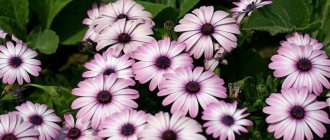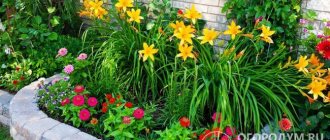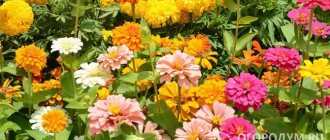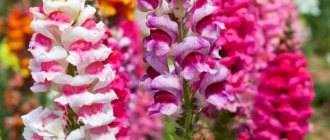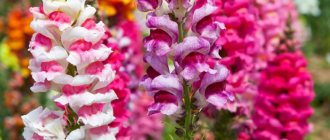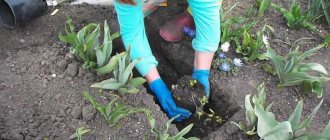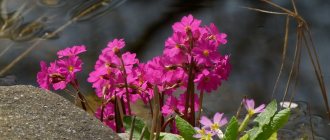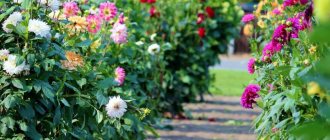Purchasing your own summer cottage is a responsible step. Regardless of its purpose, every gardener strives to allocate a corner for planting a flower garden. Here you can relax after a hard day, spend a weekend with your family in a comfortable gazebo and just admire your work. The best solution for creating a flower garden will be perennial plants. Among these flowers there are unpretentious perennials that bloom all summer; photos with the names of these plants can be found in the materials of the article. You will also learn about the benefits of perennial plants and the secrets of creating colorful flower beds.
Garden perennials - advantages and disadvantages
Plants that renew their life cycle annually are called perennial. This flower is helped by underground organs - bulbs, rhizomes, tubers. But there are also individuals that renew themselves by self-seeding. You can grow a perennial in the country using seeds or cuttings.
Know! If you buy a cutting, it can be quite expensive, but the grown bush will more than pay for itself in a few years. It will delight you with flowering every year, and the resulting offspring can be used to increase the plantation and even for sale.
Experienced summer residents prefer perennials, because they have a number of undeniable advantages:
- Unpretentiousness.
- Frost resistance.
- Low maintenance requirements.
- They can grow in one place from three to 10 years.
- There is no need to grow seedlings every year.
- They reproduce easily.
- They allow you to create a colorful flower bed that will not require updating for several years.
- A wide range of seedlings, different varieties for every taste.
Speaking about the disadvantages of garden perennials, summer residents note that due to the structure of the root system, they are more often exposed to diseases of underground organs. Some individuals need more careful supervision, for example, climbing roses, clematis, and tulips. The initial formation of a flower garden will require investment, sometimes considerable, it all depends on your preferences and requests.
Catalogs from online stores, encyclopedias of garden plants, as well as photos of ready-made solutions for garden design, where you can see how a particular flower looks in real life, will help you choose the right specimen.
For benefit
Many plants are excellent helpers in the fight against insect pests, and at the same time they are beautiful decorations in the flower garden. Here is a list of the most useful flower crops:
- Marigold;
- Tansy;
- Calendula;
- Dalmatian chamomile;
- Geranium.
Marigolds are most common among summer residents. The flower culture is distinguished by its beauty, abundant, long-lasting flowering. No special care required. Plants produce phytoncides that small pests do not like. This saves the future harvest.
Marigolds repel pests with their scent and attract beneficial pollinators.
Tansy is poisonous to some insects due to its essential oils. So the aroma of a yellow flower repels Colorado potato beetles, cabbage whites, and weevils.
Calendula is an excellent crop protector. Calendula plantings not only repel spiders and bugs, but also prevent fungal diseases.
Dalmatian chamomile is a natural insecticide. The flower contains substances that cause paralysis in insects. Harmless to people and animals.
The smell of geranium repels flies. If the plant is planted between Victoria bushes, protect the berries from aphids. All flower crops are brightly colored and can decorate any flower bed.
The best garden perennials photos with names, flowering dates
And now let’s get acquainted with a review of the best representatives of the flora, capable of presenting colorful fragrant bouquets even to a busy gardener. For convenience, we will distribute them into several groups.
short
Low-growing perennial flowers are unpretentious and versatile. They will fit organically into any corner of the garden: they will fill a ridge with a single canvas, cover an empty piece of a flowerbed with a dense clearing, become the edging of a border, a path, or decorate the foreground of a flower garden. Summer residents preferred the following low-growing representatives of the flora:
- liatris;
- clove-herb;
- armeria seaside.
Liatris is a low bush up to 45 cm tall. The underground part is represented by a rhizome that requires division and replanting every three years. The flower has erect stems densely crowned with simple linear leaves. Liatris flowers are presented in baskets that lack reed flowers. They sit tightly on spike-shaped peduncles up to 35 cm long. The spikelets are painted in purple, violet and white shades. They go well with wildflowers and look good along the border and in the foreground.
On a note! The bright spikelets of liatris remain fresh for two weeks after cutting.
Liatris is unpretentious to the soil, does not tolerate damp places, prefers sunny areas, and easily tolerates heat and drought. It needs shelter only in snowless winters; it is recommended to cover the rhizomes with spruce branches to protect them from rodents.
Carnation grass forms loose clearings consisting of thin graceful stems. The growth of the bush is up to 40 cm. The leaves are stalk-embracing, small, pointed. Carnation flowers are simple wheel-shaped, 12-15 mm in diameter. The grass blooms profusely throughout the summer. The color of the corollas is white, pink, purple, red with a ring of contrasting color near the throat. The culture has high winter hardiness and prefers dry sandy soils in open sun or light partial shade. It easily tolerates clump division and germinates quickly from seeds. Ideal for rock gardens and border decoration.
Armeria seaside forms dense, low-growing cushions 15-20 cm high and wide. The bush consists of narrow blue-green leaves with a blunt end, collected in basal rosettes. The inflorescences are capitate, the length of the pubescent peduncle is up to 20 cm. The inflorescence consists of many small flowers of white, pink or purple hue. Forms with decorative foliage were developed. The decorative period lasts more than two months, flowering begins in late spring, and repeated budding is often observed in the fall.
Armerias are drought tolerant and prefer acidic, moist, sandy loam soils. They grow well in sunny open places. For the winter, the bushes are covered with spruce branches, division is carried out every 5-6 years. Ideal for filling ridges, decorating rocky gardens, borders.
Advice! Armeria goes well with the decorative foliage forms of creeping thyme, creeper, phlox, bells, and sedum.
Medium height
The second tier of the flower bed is usually filled with plants 40-70 cm high; this group is called medium-sized. It constitutes the main focus of the flower garden, and therefore requires careful selection of “candidates”. Experienced gardeners preferred the following perennial flowers:
- doronicum;
- daylilies and lilies;
- rudbeckia;
- echinacea;
- coreopsis.
Doronicum is a bush with erect stems reaching a height of 40-70 cm. The underground organ is a low-branched rhizome. The dense stems of Doronicum are covered with alternate scale-like leaves with a small edge. At the top of the stem there are yellow inflorescences-baskets with a diameter of 4-6 cm. They can be single or collected in small shields of 2-5 baskets. Blooming doronicum can be observed twice a season - at the beginning and end of summer.
Doronicum prefers well-fertilized soil with a loose structure. Loves abundant watering during flowering and needs to mulch the substrate. Winter hardiness is high, does not require shelter, prefers partial shade. Propagated by dividing the rhizomes every 4 years in the fall.
Remember! Doronicum has no place under trees, it will not bloom there. Goes well with any flowers and decorative foliage crops.
Daylily and lily will take their rightful place in any flower bed. Due to the wide range of colors, variety of varieties, bush sizes and corolla diameters, they are very popular among gardeners. The daylily bush will retain its decorative appearance even after the buds wither. Lilies are more capricious and are more often attacked by rodents. Therefore, they are planted next to imperial hazel grouse, which have tubers with a characteristic garlic aroma. For the winter, you should carefully cover the plantings and take measures to protect them from mice.
Caring for the crop, the degree of frost resistance, and the duration of the decorative period depend on the variety. Thanks to the wide range, you can create a bright composition that will bloom for several weeks in a row.
Rudbeckia, Echinacea and Coreopsis are typical daisies from the Asteraceae family. The baskets of these representatives of the flora reach 10-15 cm, have bright, cheerful colors of the petals - yellow, orange, red and combinations of these colors. Echinacea has purple-pink baskets. These long-flowering perennials delight the eye in the summer for 2-2.5 months. The bushes reach a height of 60-90 cm, consist of erect stems and openwork foliage.
Rudbeckias, echinaceas and coreopsis love fertile soil; the site should be sunny. They will need more moisture during flowering. There is no need to cover for the winter in central Russia. Rhizomes are divided every 3-5 years.
On a note! Cheerful daisies are organically combined with blue flowers - delphinium, sage, speedwell, and hybrid cornflowers.
Tall
The background of a prefabricated flower bed or the center of a massive mixborder is unthinkable without unpretentious tall perennial plants. Popular among gardeners are:
- park roses and floribunda;
- buzulnik;
- delphinium.
Park roses are the closest relatives of rose hips, so they have a very persistent character and easily tolerate frosts. At the same time, the beauty of these plants is simply amazing; you can select several seedlings with different shades, then the garden will always look elegant. Park roses are characterized by remontability, the ability to bloom throughout the season.
Floribunda is also an unpretentious rose. It is a bush-bouquet consisting of dense inflorescences. Each bud has a diameter of 4-6 cm, the range of colors of the corolla is very diverse. The height of the bush is up to 1.5 m, minimal care is required. Roses need rich soil; fertilizing is periodically applied to maintain decorative properties. It is better to choose a planting site that is shaded during the midday hours.
Important! Floribunda will need shelter for the winter.
Buzulnik is a powerful representative of the flora, growing up to 120 cm. The bush has large alternate leaves of a heart-shaped or kidney-shaped form (up to half a meter in diameter). Buzulnik inflorescences are yellow or orange baskets with one row of petals. The heartwood is yellow or brown. The diameter of the basket is 2-5 cm. The flowers are collected in racemes, spikelets or corymbs. Flowering occurs in the second half of summer. The height of the flowering stem is up to two meters.
Buzulnik tolerates shade and excess moisture well, so it is often planted near bodies of water. It is not picky about the soil, loves plenty of watering, needs a garter, and does not get sick. The bush can be divided after 3-4 years.
Delphiniums (pictured below) are tall giants up to two meters tall. There are so many varieties of this plant that it can be difficult to choose the right one. Large candle-shaped inflorescences are full of different shades; the decorative period is long. The bush is crowned with openwork leaves, which gives it additional charm. Terry forms have been developed, large-flowered, with an eye. Blooms from the end of June for 4-6 weeks, winter-hardy. Needs gartering, rationing the number of flower stalks, loosening, and fertilizing. Division is carried out every 3-4 years.
Climbing plants are of considerable importance for the vertical landscaping of a site. We advise you to purchase seedlings of clematis, climbing roses and wisteria vines. These popular perennials have a long decorative period, but will require a great deal of gardening knowledge.
Know! The whimsical nature of vines is associated with special requirements for pruning and preparation for the dormant period.
Creeping plants - description and photos of species
Creepers will help disguise an old building or an unaesthetic fence, and they can also effectively decorate the wall of a house, terrace, balcony, veranda, gazebo, and even the entire building. To fix plants in a vertical position, special supports are used so that the plants wrap around, clinging with tendrils, thorns or leaves. For greater practicality, they are tied to a support.
Creepers are a natural material for decorating gazebos, fences, and buildings.
Perennial vines include: ivy, wisteria, clematis, honeysuckle honeysuckle, actinidia, wild grapes, lemongrass.
The most prominent representatives:
- Climbing rose is the result of breeding work on crossing wild and garden species of roses. Large inflorescences of small flowers thin out the pleasant and delicate aroma. They bloom for up to 30 days, but there are varieties with repeated flowering. There are different colors and shades: red, pink, white, yellow, salmon pink. Very whimsical, demanding in watering, sunlight and insulation in winter. Arched, whip-like shoots require rigid support;
- Wisteria is a favorite among gardeners. The main decorative feature is openwork foliage flowing to the ground, unusually beautiful clusters of flowers up to 50 cm in length. It will surprise even aesthetes with its beauty. Very demanding in care and climatic conditions. Pruning is required 2 times a year.
Wisteria is a rainbow waterfall of bright colors and flowers in your garden.
Perennials bloom all summer
Not all perennials can boast of flowering throughout the summer, but the representatives of the flora listed below will make the dacha elegant by giving a bright summer dress:
- aquilegia;
- salvia;
- phlox.
Aquilegia bushes grow up to 0.5-1 m tall and have a powerful taproot. The leaf blades are divided into three dissected lobes; there are varieties with variegated foliage. The unusual flower has a complex structure and is equipped with spurs. The corolla reaches a diameter of up to 10 cm, the color palette is wide. The petal and spur are painted in different shades. Aquilegias love open sunny places, rich soil, and abundant watering, because the second name of a perennial is a catchment area. Hybrids need winter shelter. Division is carried out every 5-6 years.
Botanical species of sage (salvia) have high frost resistance and attractive appearance. The growth of the bush is up to 120 cm, the leaves are pubescent dark green. Small two-lipped flowers of blue or purple shades are collected in long spikelets. Garden hybrids have a wide range of petal colors. Salvia loves the sun, is drought tolerant, and prefers rich, moist soils. Rejuvenation is performed as needed every 5-6 years.
Know! Salvia is a medicinal plant and a valuable honey plant. The decorative qualities of hybrids will not leave even discerning gardeners indifferent.
Phlox forms dense clumps 30-150 cm high. The stems are straight, the leaves are lanceolate, entire. Wheel-shaped flowers with five petals boast a thick, pleasant aroma. They are collected in corymbose or paniculate inflorescences. The color of the corolla is white, scarlet, blue, pink, varieties with an eye and double flowers have been bred. Phlox is demanding when it comes to feeding, grows well in partial shade on soil rich in organic matter, and loves a moist substrate. For the winter, the clump is cut and mulched with peat to a height of 15-20 cm.
At the gazebo
Plants near the gazebo not only have a decorative function, but also protect from the sun and shelter from the wind. The most popular climbing plants include:
- Wisteria;
- Clematis;
- Climbing rose;
- Akebia;
- Passiflora.
Wisteria looks impressive on a gazebo and arched structures. Blooms from late March until the end of summer. During the flowering period, clusters of different colors are formed on the vines. The soil around the tree trunk should be moist. Otherwise, the plant will drop its buds.
Wisteria is the most spectacular plant for a gazebo
Clematis is popular among summer residents for its abundant flowering. This loach requires care. The soil should be fertilized and loosened. Attach young shoots to a support. The planting is afraid of drafts.
Climbing rose blooms in summer. Scourges grow up to 9 meters. Rose loves a lot of sun, little water.
Akebia is a vine 3-6 meters long. Blooms from spring throughout the summer. Chocolate-coffee aroma. For abundant flowers to appear, it is necessary to plant the akebia in an area that receives a lot of sunlight.
Passionflower needs sun and loose soil. It is better to spray the planting with warm water. Blooms from March to late August.
Unpretentious perennial flowers for Siberia
In areas of risky farming, not every perennial can survive the winter, so gardeners give preference to frost-resistant species:
- pansies;
- daisies;
- obrieta.
Violets, aubrietas and daisies are magnificent low-growing ground covers with an unpretentious nature. Violets form a small rosette of ovoid leaves with a wavy edge. Single flowers have different colors. The height of violets is up to 20 cm. They love fertilized soil and sunny places. Regular watering during flowering prolongs the decorative effect.
Attention! Violets do not tolerate fresh organic matter.
Aubrieta forms hemispherical flower mats up to 15 cm high. This beautiful perennial is completely covered with small flowers during budding. The cushion preserves greenery under the snow and is decorative at the beginning and end of summer. Aubrieta needs pruning, tolerates drought well, loves sun and nutritious soil. Winter hardiness is complete.
Daisies with small chamomile-like flowers captivate with their beauty. They grow quickly, so the clump will have to be divided periodically. Baskets with a golden core have white, pink, scarlet petals. Many terry and pompom varieties have been developed. Perennial daisies do not need shelter; they grow in sunny areas and love liquid mineral fertilizers.
In a flowerpot
When there is not enough space on the site to set up a flower garden, you can plant flower crops in flowerpots. Such a composition will decorate not only the site with its appearance. It is also used in landscape designs. Flowers grow in it throughout the summer. The most popular include:
- Petunia;
- Fuchsia;
- Calibrachoa;
- Begonia;
- Balsam.
Ampelous and cascading petunias . In the first ones, thin stems descend downwards. In the second, they go up, and a large number of shoots fall down like a waterfall. The plant blooms profusely and for a long time, almost until frost. The flowers vary in size and color.
Petunia is not only the most popular, but also the most suitable flower for hanging flowerpots
Ampelous fuchsia is flexible and falls down. It does not like the sun's rays, so the pots should be placed in the shade. Fuchsia is afraid of frost.
Calibrachoa prefers full sun and places sheltered from the wind, but does not like direct midday sun. Does not require constant watering, prefers spraying. Withered flowers are picked off. In their place, new ones are formed. By July, flowering wanes. The flowers are bright orange, yellow, red.
The shoots of ampelous begonia grow upward and then fall down under the weight of flowers and leaves. The colors are varied. Pots with begonias are taken outside in late spring and early summer, when warm weather sets in. The plant loves moist soil.
The balsam ampelous bush is light and small, perfect for flowerpots. It is better to place the pot in a place protected from the wind. Blooms profusely until October. The flowers are bright and varied in color. The plant is not afraid of waterlogged soil.
Long-flowering frost-resistant perennials for the Urals
The climatic conditions of the Urals also encourage gardeners to select frost-resistant green plants. Ural summer residents prefer the following crops:
- astilbe;
- buzulnik;
- sedum
Astilbe is a rhizomatous herbaceous perennial with erect shoots. The height of the stems is 10-200 cm. The dark green foliage is densely dissected and sits on long petioles. Tiny flowers of white, red, pink or purple are collected in paniculate inflorescences. The decorative period is 4-6 weeks and falls in mid-summer. Astilbes withstand frost, love moisture, and do not get sick. Division is carried out every 4-5 years.
Know! An area with partial shading will extend the decorative period of astilbe.
We have already talked about buzulnik, so we will focus on sedum or sedum. This ground cover has many faces, its appearance varies depending on the species and varietal. The succulent is equipped with fleshy leaves that are round or needle-shaped. The foliage is colored not only in green tones, but also in variegated forms.
The sedum produces several flower stalks strewn with small star-shaped flowers. The color of the corollas is different. Sedums prefer sunny places with poor soil, do not need additional irrigation, and are afraid of waterlogging. Curtain transplantation and rejuvenation is performed every 5 years.
Undemanding biennials
And among biennial flowers you can find specimens that are distinguished by their undemandingness and hardiness.
Forget-me-not garden
The most unpretentious variety of this crop is the garden (or alpine) forget-me-not. It is a perennial plant, but is grown as a biennial.
It blooms for about one month, as a rule, flowering occurs in the second half of May or early June.
There are no special features in the agricultural technology of growing forget-me-nots. Feels best in partial shade. It can independently reproduce by self-sowing without the participation of a grower.
To plant forget-me-not seedlings, you need to choose common bowls, the seeds are distributed at a distance of 1.5 cm, covered with river sand with a layer of 1 mm. It needs to be planted very early, in November, December, January.
Daisy
The naive and delicate beauty of daisies will appeal to many. A perennial crop, but grown as a biennial. In general, it is unpretentious in care, with the exception of watering, moisture should be supplied regularly.
Growing is optimal in open, sunny places; it is unpretentious in terms of soil, but it is better to plant on drained, light, cultivated soil.
Daisies are planted as seedlings in the second half of March, sown in a common wide and low container. The seeds are evenly distributed over the surface of the substrate, sprinkled with a thin layer of sand (literally 1 millimeter) on top.
After the entrances grow, it is necessary to thin them out, removing the weakest ones.
Turkish clove
Turkish carnation (or bearded carnation) is another interesting, unpretentious representative of biennial flowers. It blooms in the second year of cultivation (as a rule, flowering lasts 30-45 days, occurring in June). It has interesting colors that can be patterned.
Prefers sunny places or areas with diffused light. Blooms from late June until frost.
It is best to sow Turkish cloves for seedlings in late March or early April. It is recommended to initially select individual cups and plastic cassettes (since the crop does not tolerate carelessly picked picking), but you can also plant a common bowl.
- In the first case, the seed is placed in a hole 3 mm deep and covered with sand or earth.
- When planting in a common bowl, you need to make grooves with an interval of 3 cm and the same depth, spread the seeds at a distance of 3-4 cm and also cover them.
cornflower
Cornflower is a very hardy flower; it is not afraid of heat, frost, or cold snaps. Only sunny, open places are suitable for him. Drained, fertile soil is also suitable. It is completely undemanding in terms of care.
Beautiful flowers will look great in any corner of your garden.
It is better to plant cornflower seedlings in early April; seeds are sown in a common box at a distance of 3 centimeters from each other, and the top is covered with soil 3-4 millimeters thick. You can also plant them in cassettes and cups.
We create a blooming garden with our own hands: how to form a flower bed from perennials
To design a colorful flower bed, it is important to think through the smallest details, because its inhabitants will “live” in a permanent place for several years. By comparing the color options suggested above with descriptions and photos, you can independently think through the layout of the flower garden. Free computer programs that are used to design the landscape design of a site will help you with this. You can also turn to professionals - landscape designers or gardeners, who will competently select crops for decorating any type of flower bed, comparing their qualities, petal color, and growth.
When forming a flower garden, you should rely on these rules:
- Preliminarily study the varieties of flower beds and choose an option that is suitable in shape, size, and location.
- Arrange perennials according to flowering time. It is important to select flowers so that after one species withers, the second begins to bloom, covering the dying vegetation.
- Stick to the correct grouping. Crops must be selected taking into account their height and width, and aggressiveness towards their “neighbors.” Some flowers are capable of growing quickly, oppressing other individuals, and if the grouping is incorrect according to growth, a loss of decorativeness due to shading is possible. Take care of an underground fence that will protect the flowers from the aggressive growth of neighbors.
- Select crops according to method of use. Loaches will decorate an arch or the facade of a house. Tall individuals will serve as the center of the composition or the background, and low-growing flowers will take a good place in the foreground, decorate the border, alpine hill, and fill the ridge. If necessary, you should consider reliable support.
- Do not neglect preparing the seats. Each inhabitant of the flowerbed has its own requirements for the substrate, the degree of illumination, the pH of the soil, and its structure.
- Although perennials are unpretentious, when planting you need to immediately apply long-acting fertilizers that will nourish the green plants, maintaining health and lush flowering.
Advice! If the selected representatives of the flora have different soil requirements, the planting site should be prepared taking into account individual needs.
Near the pond
Any country pond can be decorated with aquatic specimens. The most famous among them:
- Siberian acacia;
- Sedge;
- Loosestrife;
- Darmer;
- Whitewing.
Siberian acacia is a shrub. Grows up to 2 meters. Blooms in July for 2-3 weeks. During flowering it is covered with small yellow flowers. No maintenance required.
Sedge feels good in the shade. Retains its appearance until mid-winter.
Merlin loves partial shade and moist areas. It reaches a length of up to 1.5 meters. Inflorescences are purple.
Darmera is characterized by volume. Blooms from the second half of spring. Frost-resistant. Prefers shaded places.
Calliper by large leaves and colorful blooms. The berries of the plant are poisonous. The whitewing is unpretentious. It instantly takes up free space, so it is planted in a box and placed in a pond. Flowering period: spring-summer.
There are many flower crops for the garden. It's up to you to decide what plants to grow on your property. In order for flowers to please with their decorative value for a long period of time, you need to know the rules of selection and care.
Arabis
The desire to cover open ground with a flowering blanket is easily fulfilled thanks to Arabis. This “wild violet” reaches 20-30 centimeters in height, but blooms thickly before the onset of autumn frosts.
Arabis welcomes the following growing conditions:
- Air temperature – plus 18-26 degrees Celsius;
- Very loose and moderately moist soil;
- Good lighting.
Arabis spreads out with its curly trunks, which take root. Unpretentious blooming flowers can be trimmed periodically to prolong flowering. Irrigation is carried out as the soil dries and alternates with careful loosening of the upper crust around the crop.
Nasturtium
It can be perennial or annual, and in appearance it is bushy, dwarf, creeping with a stem length of up to 4 m. Most varieties bloom from June to October. It needs regular watering only after moving to open ground. This usually happens in early June. When the nasturtium gets stronger, it is enough to water it as the soil dries out: excess moisture stimulates the abundant growth of greenery to the detriment of flowering.
Photo: Instagram best_family_garden
Photo: Instagram natali290669
- Landscape
What flowers to plant in the ground in spring: 10 suitable types
Geranium
Not every plant manages to decorate a site with inflorescences and foliage from spring to late autumn. Perennial geranium is an exception. If its baby bushes are planted in May, then in summer the maple-shaped leaves will be decorated with small, pretty flowers. Closer to August, the purple lights will dry out, but the foliage will begin to turn red.
Like wild grapes, geranium does not require:
- Lots of light;
- Soil that is too wet.
Although even the most unpretentious flowers are recommended to be watered and loosened. Moreover, geranium can curl. Therefore, its bushes are often planted in hanging flowerpots.
Bruner
Unlike the previous unpretentious flowers, Brunera is quite squat. However, this does not prevent it from spreading burdock leaves and later blooming with small purple flowers. The foliage is beautiful thanks to its two-tone color in the form of a silver patina and an emerald background.
To grow such an “elven crown”, you will have to:
- Wait until July and August, when the earth is warm enough and daylight hours are slightly shorter;
- Choose a dark and damp place for planting;
- In the evening or in cloudy weather, plant rhizomes or seeds in the hole.
Brunera will bloom only in April-May next year, but the revival of the shady corner is guaranteed. The main thing is to keep the soil moist.
